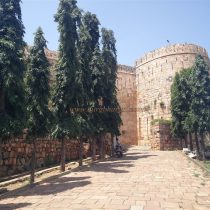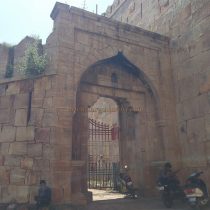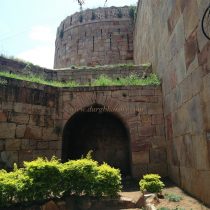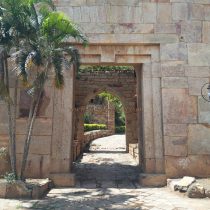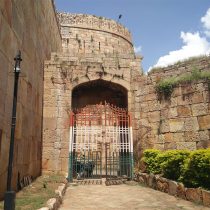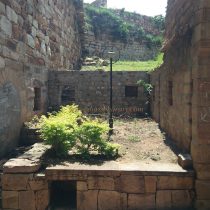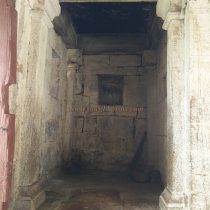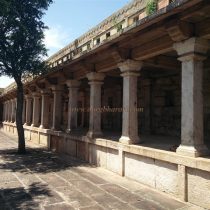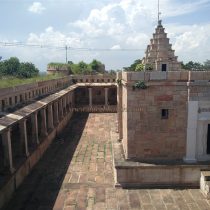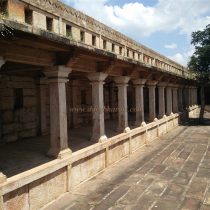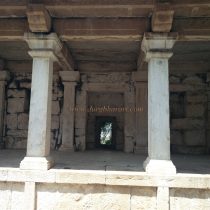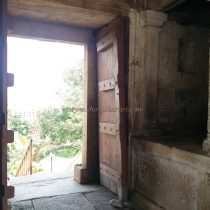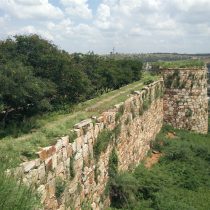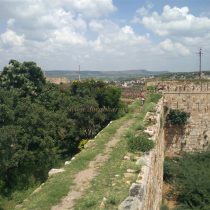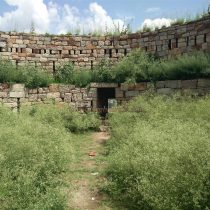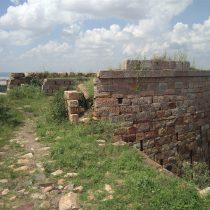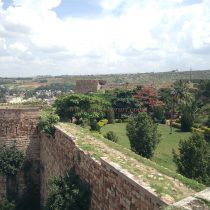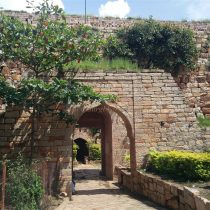SAUNDATTI
TYPE : HILL FORT
DISTRICT : BELGAON
HEIGHT : 2270 FEET
GRADE : EASY
Yallamma Devi, famous in Maharashtra and Karnataka, is located in Saundatti taluka of Belgaon district. Parasgad fort was built by Shivaji Maharaj on the hill where the temple of Goddess Yallamma is located. This province, which was under the control of Shivaji Maharaj, was annexed to the state of Karnataka in the process of linguistic transformation. Most of the forts in Belgaon district are of a ground fort or fortress type with an exception of very few hill forts. The forts that can be called hill forts are on a small hummock or a hill. Some of these forts were built in the 18th century and have remained intact since no battle had taken place on them. One such fort that is in good condition is present in Saundatti. Saundatti is a taluka town located at a distance of 87 km from Belgaon.
...
At a distance, on entering the city, one can see the Saundatti fort on the hill in the center of the city and the bastions of the Parasgad fort on the hill behind the city. Both these forts are known as Saundatti fort in the city. Although the fort was built in the 18th century, the fortification architecture was used extensively in the construction of the fort. The main entrance of the fort is on the east side and one can enter the fort only after crossing three gates. The middle of these doors is in the line of fire thus forming a battlefield. The main gate is enclosed by a secondary rampart on the outside. The ramparts are built up to the bastion and a second gate is built here. From the bastion, a thick wall has been built in the direction of this door and the path in front of this second door has been paved. After entering the fort through the first north-facing gate, we reach this closed battlefield in front of the east-facing gate. The ramparts outside the main fort have two guard porches and steps to climb the outer ramparts. Carved stones with upside-down U-shaped designs are built on these entire ramparts. The ramparts have curtain walls and barrage to shoot guns and cannons. On the upper side of the door, there are carvings and on the left side, there is a small door to get to and from the fort in case of an emergency. There is a third door on the inside of this door and there are guard porches on both sides of these two doors. Upon entering through this door, there is a large square-shaped well on the left and steps leading to the citadel in front. Although the water from the well is not potable, the citadel has arrangements for drinking water. After climbing the stairs, we reach the gate of the citadel. The wooden doors of the gate are still standing today and there are guard porches on both sides on the inside of the door. There are rooms on all four sides of the ramparts and the entire pavilion is weighed on stone pillars. There is a temple of Kalasiddheshwar on a quadrangle structure in the center of the fort. This is the only building in the citadel. There is a path to go to the top of ramparts in the ramparts themselves. The entire fort and the city of Saundatti can be seen from the upper part of the gate of the citadel. Situated on a small hill in the center of the city, the fort is octagonal and has eight bastions at each corner. Both the bastions near the gate are enclosed and have small doors to enter. The area of the fort is only four acres and this small fort is divided into Machi and the citadel. This square-shaped citadel is 120 x 80 feet in size and has two bastions on the ramparts behind the citadel. Apart from the main door, there is another small door to exit the citadel. As you descend the steps of the citadel, you can see a different type of snake carving in a small structure on the left. After descending the steps, on the other side of the well are the remains of the administrative office of the fort and the palace. There is a small door to exit the fort on the left after going straight up from here. Next to the door are steps leading to the ramparts. There are 7-8 such steps to reach the ramparts. As the entire ramparts of the fort are in good condition, the entire fort can be visited from the ramparts themselves. If you take a detour around the ramparts, you can completely see the fort. Each bastion has a round structure to hold cannons, and windows and barrages to shoot guns. As you walk along the ramparts, you can see two toilets and a barn on the lower side of the ramparts. Outside the bastion on the north side of the fort, there is a large lake enclosed by an elliptical rampart, but it is now dry. As the western side of the fort is not very tall and can be reached by the enemies easily, additional protection has been given to this site by digging a moat here. The city of Parasgad and Saundatti in front is constantly insight while walking along the ramparts. The fort is small in size but very beautiful. It takes an hour to complete the fort round. Saundatti is the second most ancient city in Belgaon. Six inscriptions have been found in the city of Saundatti between 875 and 1229 AD. The village is mentioned in them as Sugandhavati, Sabandhavatti, and Savadhavatti. At that time it was the main place in the province. Until the Ratt kings moved to Belgaon, Saudantti (850-1250 AD) was their capital city till 1210 AD. From the inscriptions found here, it is seen that Ratt kings are Jains and they built two Jain temples here in 876 AD and 981 AD. Here Shaiv temple of Mallikarjuna was built around 1230. On two pillars of Belgaon fort, there are two Kannada inscriptions carved in 1199. In this inscription, it is mentioned that Ratt king Krishna III appointed Prithviveer, a descendant of the Ratt family, in Saundatti. Saundatti's Rutt dynasty originated from Lateluru, i.e. today’s Latur. During Shivaji Maharaj’s period, this part which was under the rule of Adilshah came under the control of Marathas. In the year 1730, the Nawab of Savnur gave the post of Chief of Shirsingi and Saudantti villages to the Chief of Navalgund. Jayappa Desai built the fort of Saundatti in 1734, while some historians believe that Jayappa Desai built the fort between 1743 and 1751. Desai joined Hyder Ali of Mysore after he conquered the fort.
© Suresh Nimbalkar

